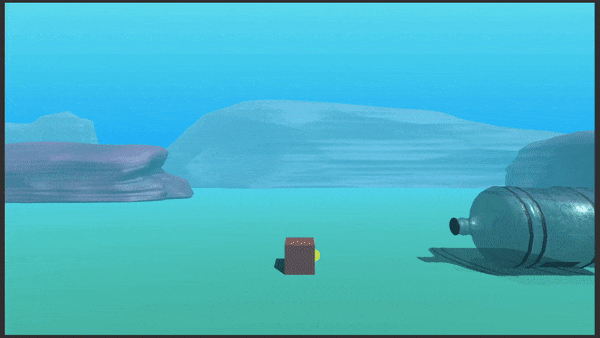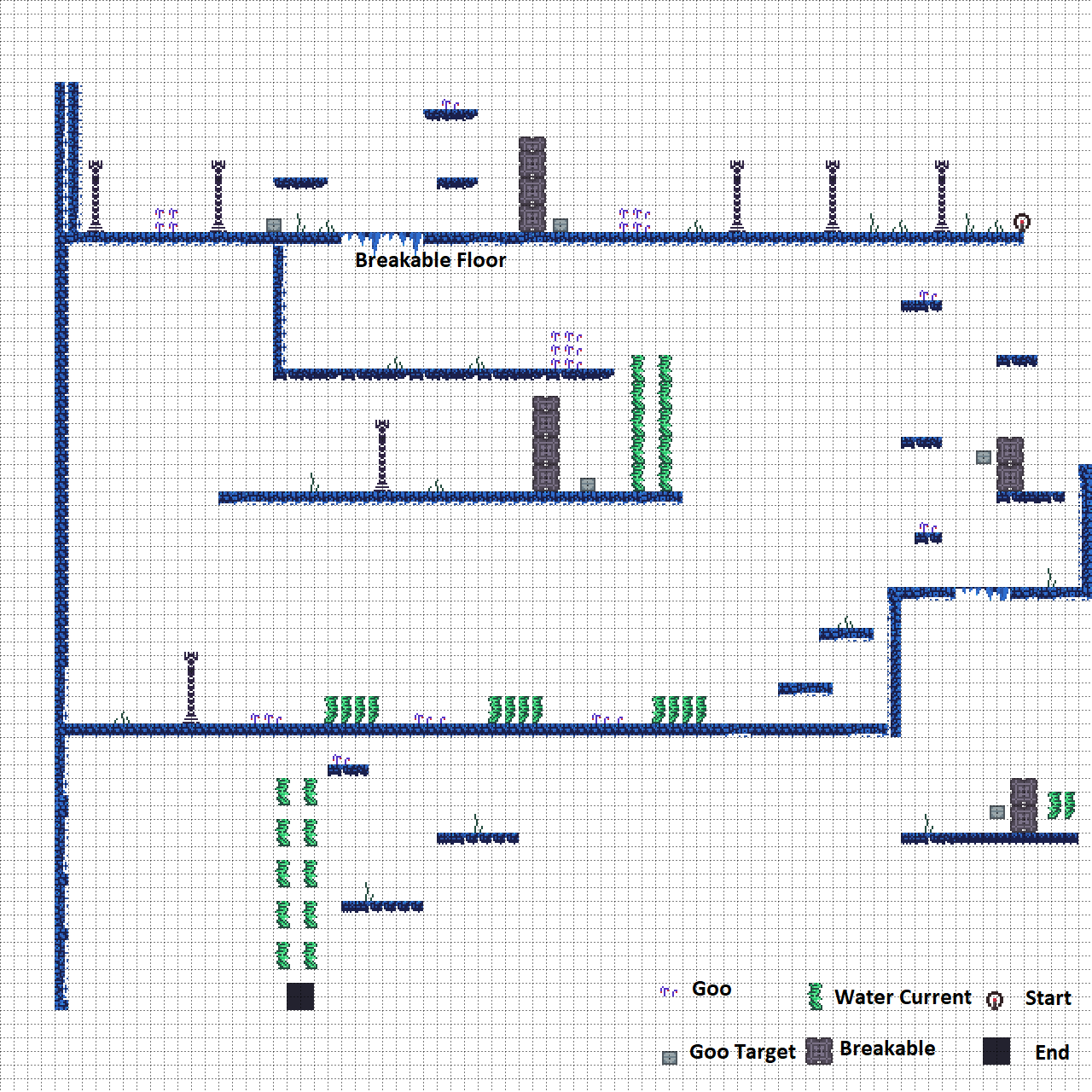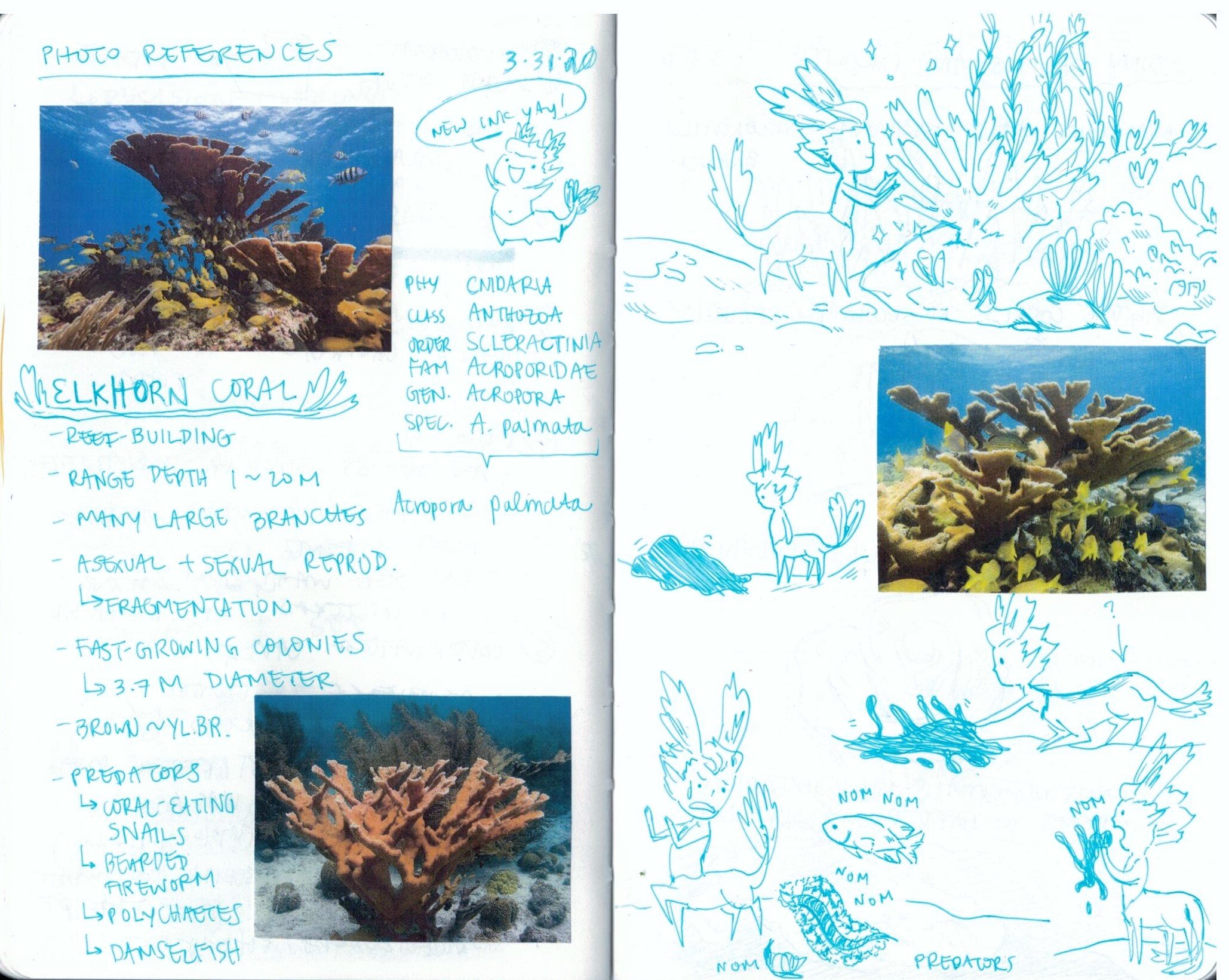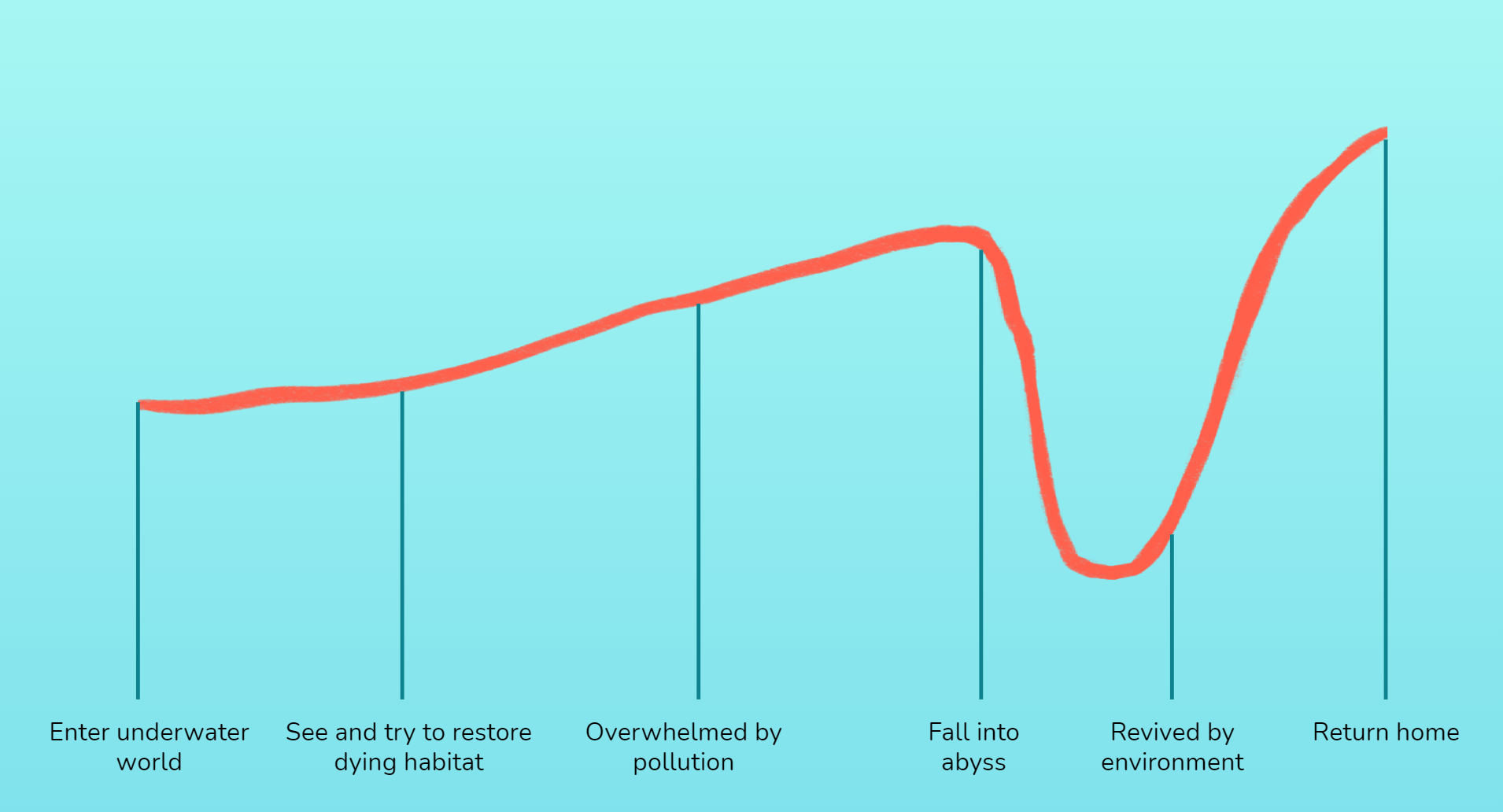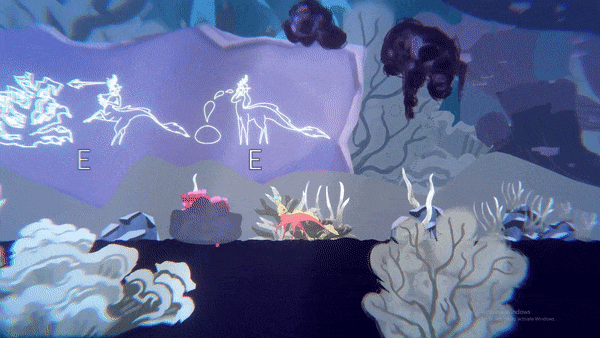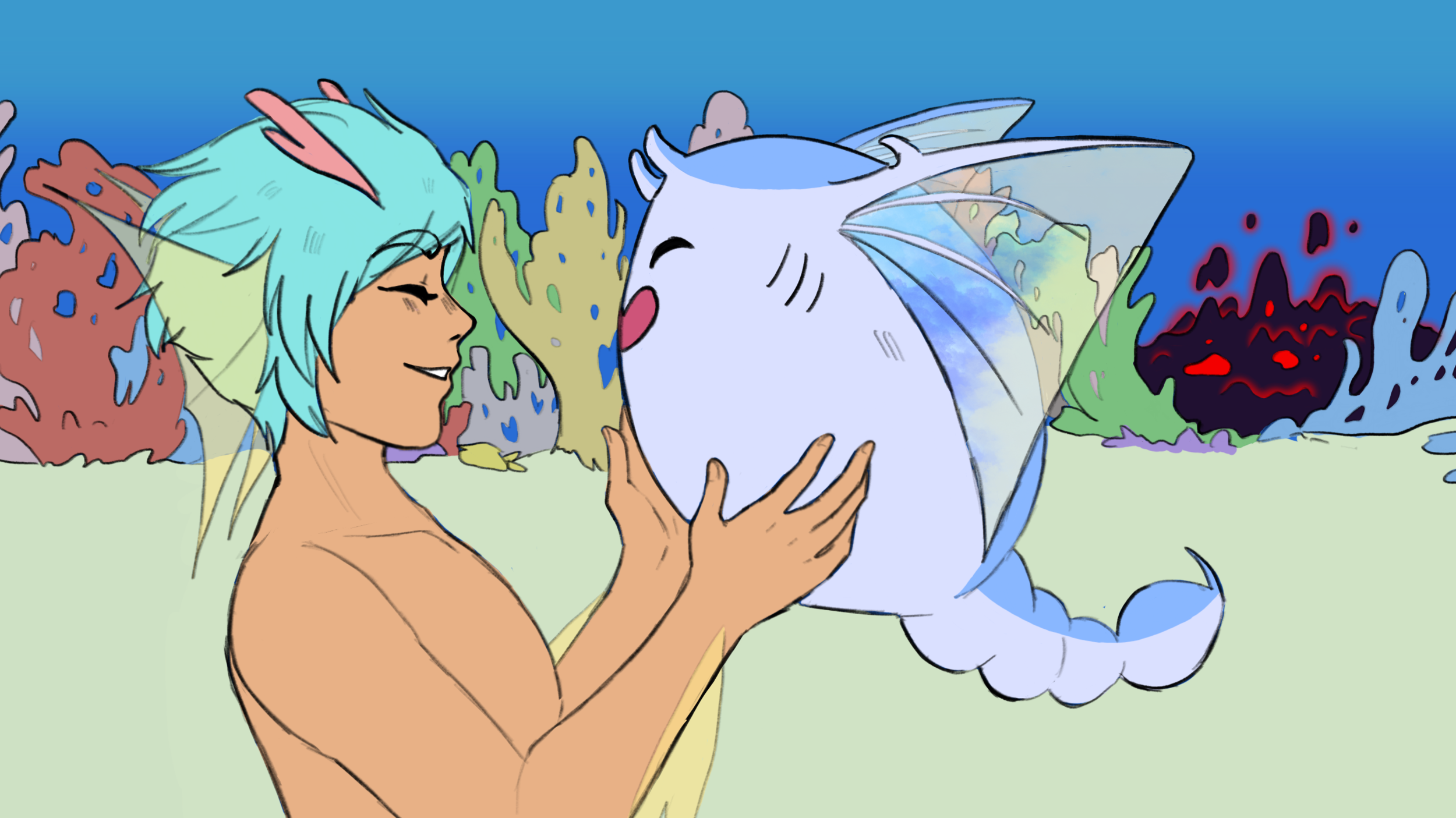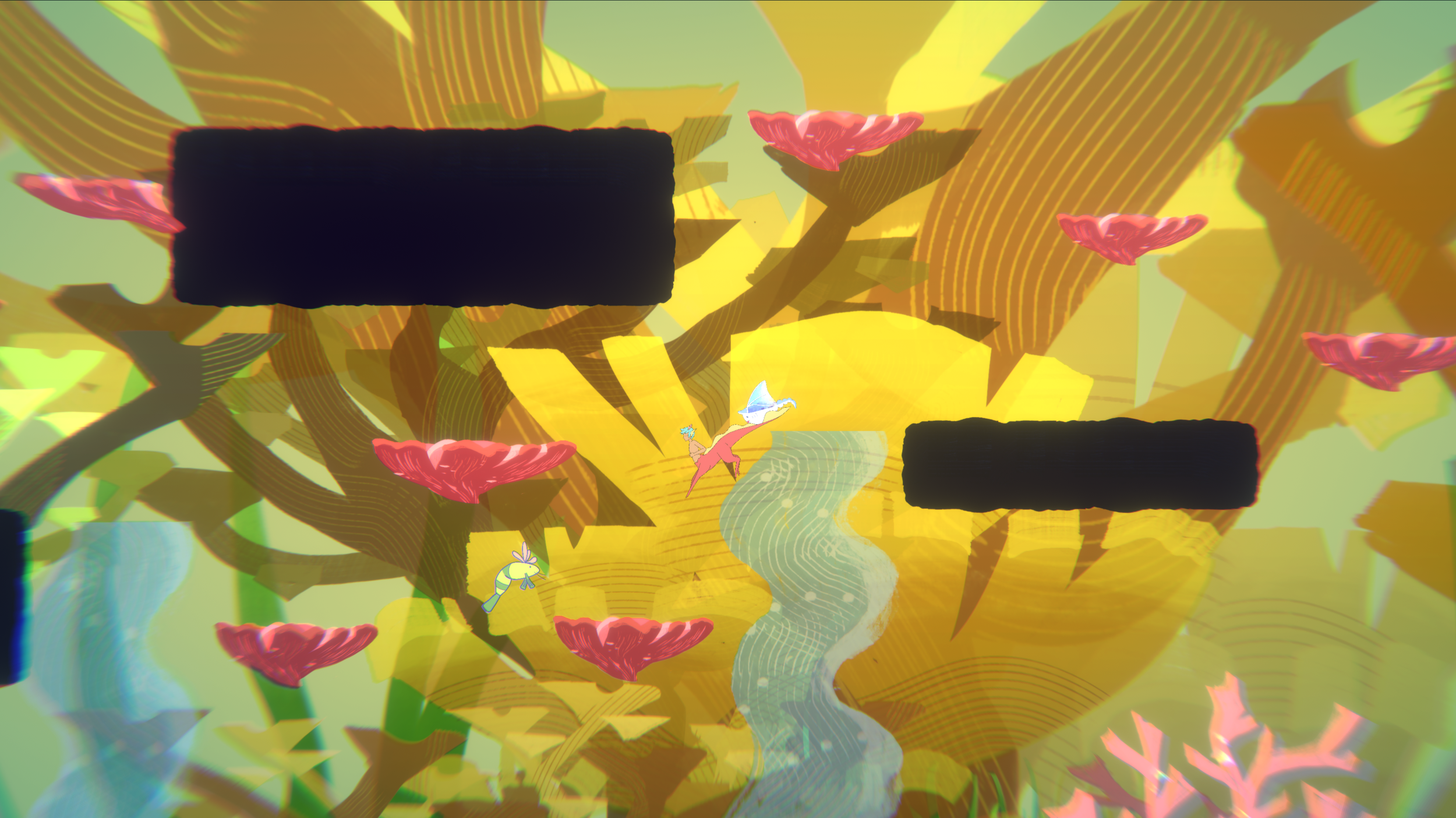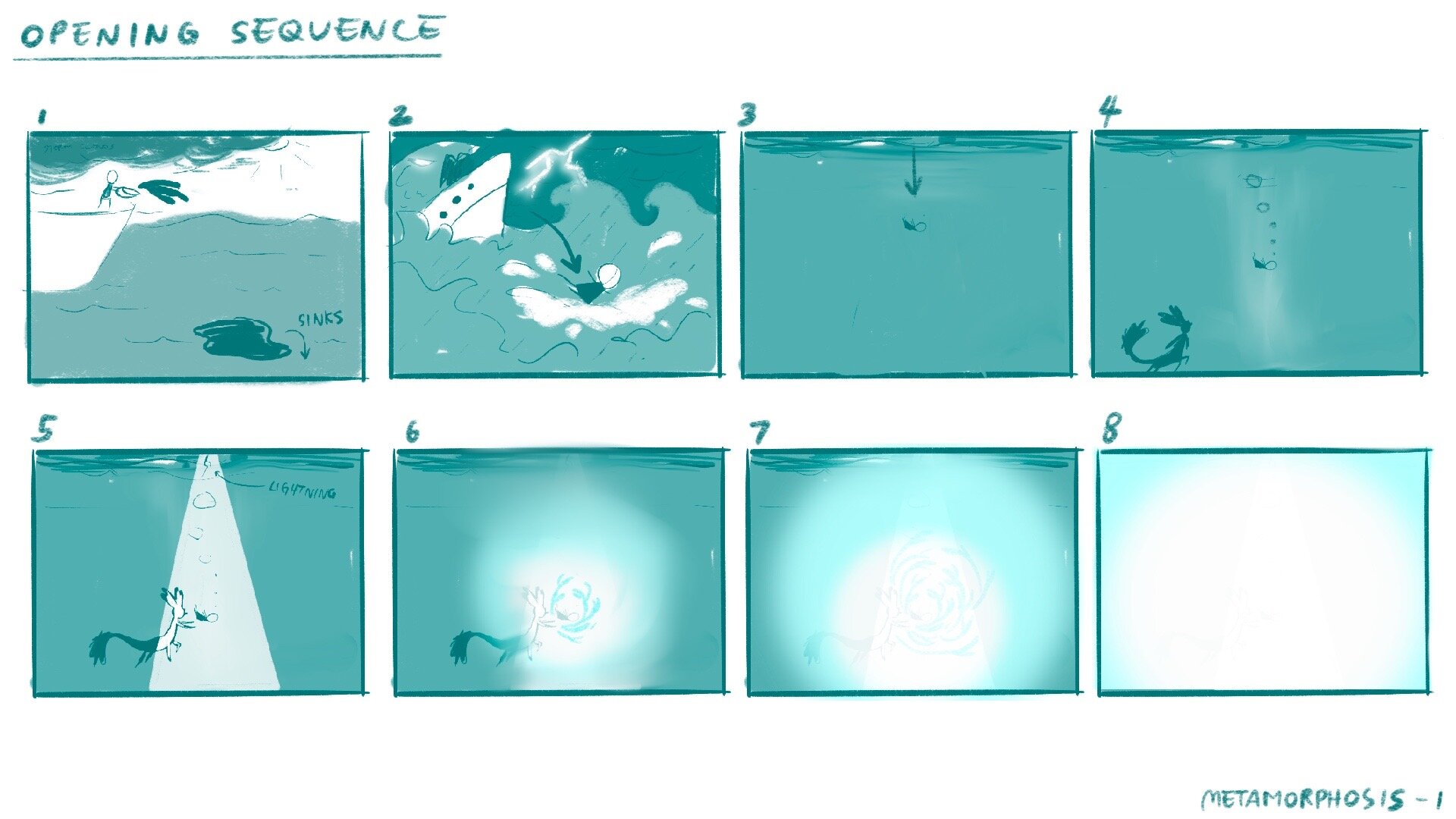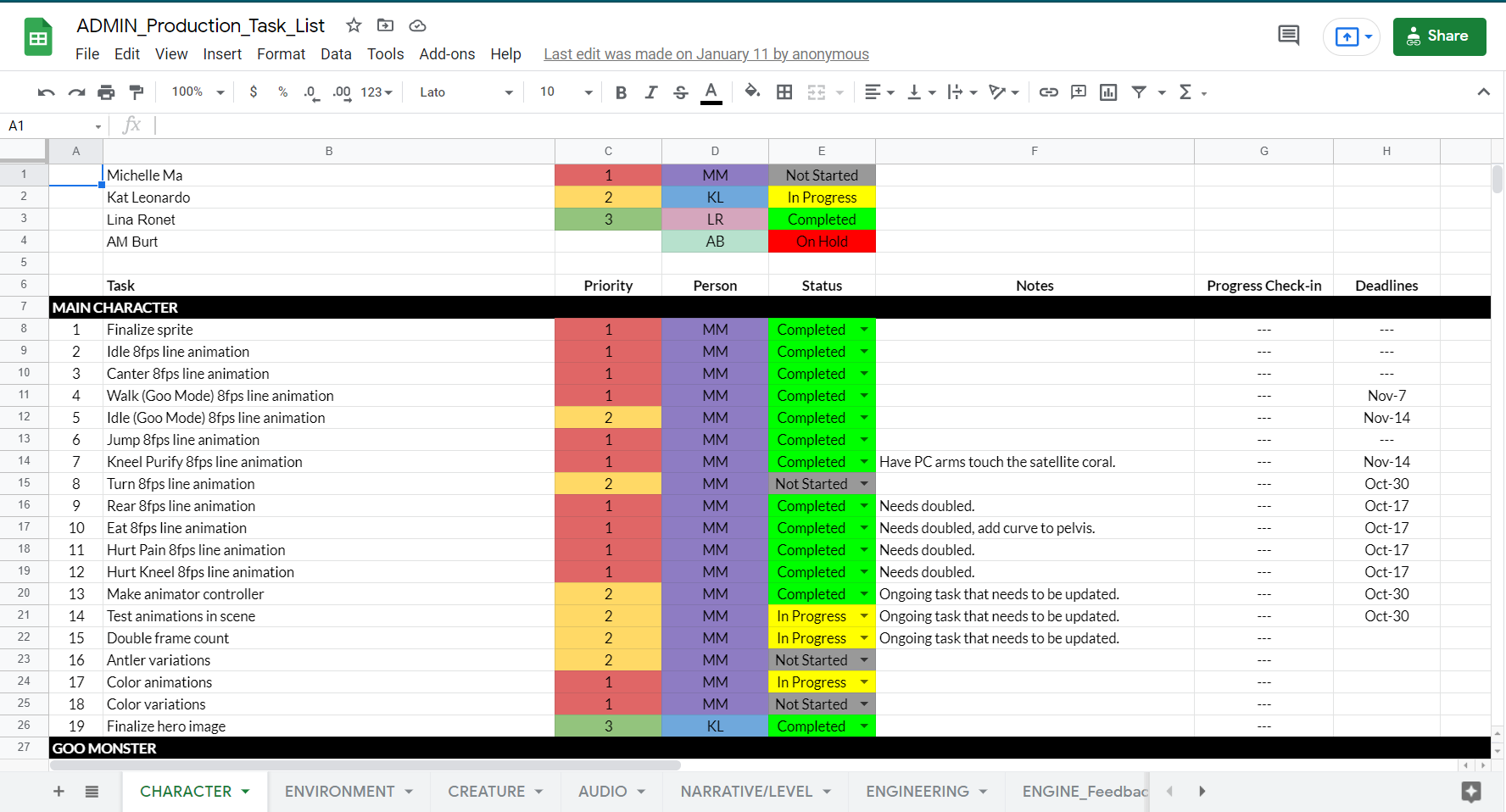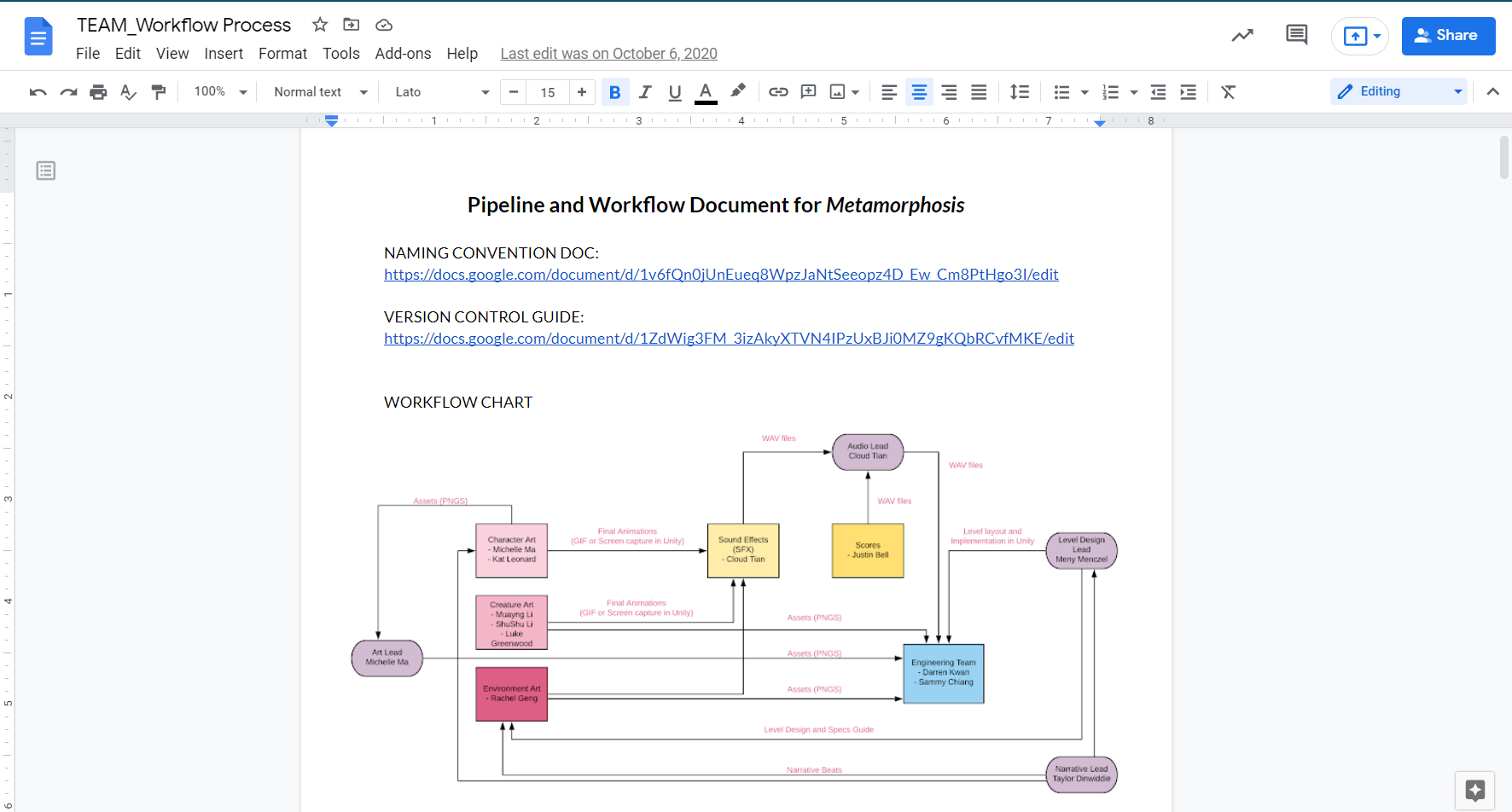What is Metamorphosis?
Metamorphosis is a 2D narrative-driven game where you play as a magical undersea creature who must consume poisonous contaminants and avoid death from toxin accumulation in order to restore their home. Throughout the game, players will experience empathy for creatures trapped by the contaminants that have invaded their home, and gratification when they successfully save them and help bring life back to the ocean.
Recipient of Alfred P. Sloan Grant for Games 2020-2021
Livestreamed at USC Games Expo 2021
showcased at Geidai Games Expo 2021
Showcased at AAIFF44 2020-2021
Project overview
Game Details
Genre: Narrative, Adventure, Platformer
Platform: PC and Mac
Game Engine: Unity
My Roles: Creative Director · Designer · Producer
Logistics
Project Duration: January 2020 - May 2021
Team Size: 24
Process
My contributions
❖ Designed initial concept and prototyped the player mechanic during Pre-Production phase.
❖ Collaborated closely with design team (level designer, narrative designer, engineers) to develop final version of core loop, player mechanic, systems, and level layout.
❖ Led and motivated a team of 23 diverse members across five time zones from multiple universities and institutions.
❖ Made decisions about feature direction and project priorities based on experience goals and project scope.
❖ Created and maintained design documents, populated and maintained Trello boards, scheduled meetings and sprint objectives.
❖ Met with different departments on a weekly basis, and held work jams and one-on-one meetings to check in with teammates.
Prototype of the player mechanic. The player consumes pollution to restore the environment.
Project Macro that outlines the major sections of the game.
Experience Goals
❖ The audience will feel awe and wonder as they step into a beautiful, fantastical, underwater world with unique characters and creatures.
❖ The audience will experience moments of joy when they save animals in need, or moments of guilt when they can choose to disregard them.
design goals
❖ Players understand and relate to the PC's situation that they need to get rid of harmful substances in order to restore their livelihood and surroundings.
❖ Art Direction: 2D hand-drawn aesthetic with flat colors overlaid with watercolor textures and dynamic lighting.
World Building
The world of Metamorphosis
Metamorphosis takes place in Oceana, a vast underwater realm where the Mother Coral and her Satellite Corals sustain diverse marine life. The Ichthyocentaurs, guardians of the oceans, wield their unique abilities to assist the Mother Coral in preserving harmony within their aquatic environments.
Mother Coral and its Satellite Coral are the only corals with a bright saturated pink in Coral Forest.
Early concept art and illustration of the Ichthyocentaur. This character became the player character of Metamorphosis. Art by Joanna Shen.
Metamorphosis centers on one of Oceana’s unique marine ecosystems: the Coral Forest. Inspired by the towering Redwood forests, I envisioned an underwater world populated with colossal, otherworldly corals.
Through my research, I discovered that Elkhorn Corals play a crucial role in forming the foundation of coral reefs. Using Elkhorn Coral as a central element, I designed the Coral Forest using its features into key aspects of the game, including the Ichthyocentaur’s horns and the forest itself. To further enrich the environment, I collaborated with my Environment Artist to introduce a variety of other corals. My Environment Artist then brought the final vision of the Coral Forest to life.
The three main types of coral we focused on to populate Coral Forest. Art by Environment Lead Rachel Geng.
To give Coral Forest more depth (figuratively and literally) and a sense of exploration, I designed it to have the player traverse through three distinct parts of Coral Forest itself: the Entrance, Main Forest, and the Depths. The three parts each had their unique color palette, certain types of coral, and creatures.
Entrance
When you start on your adventure into Coral Forest, you'll see a range of small to large corals spread out on the ocean floor. Though already large in size, given time, these corals can grow to be seven times their current size.
Main Forest
You’ll know once you enter the main forest when you see Golden Elkhorn, one of the most iconic regions of Coral Forest. These massive elkhorn corals are inspired by Giant Redwood Forests, as depicted in their sheer size and height. Plenty of sunlight shines down on the Golden Elkhorn, giving them the nutrients they need to continue growing and building the forest.
Depths
In the depths of Coral Forest, the environment starts to become more cave-like, claustrophobic, and ominous. Despite the dangerous vibes, there are creatures who live in these caves and have adapted to these unique conditions.
Creatures of Metamorphosis
The Coral Forest is home to a diverse array of unique creatures. One of the joys of Metamorphosis is discovering these fascinating beings and rescuing them from the toxic goo that pollutes their habitat. Here are just a few of the remarkable creatures you’ll encounter on your adventure.
Scat Ray
Scat Ray is Thyota's whimsical companion that follows them after they same him from the Coral Forest. His cheerful and bubbly personality brightens up even the darkest depths of Coral Forest.
Leafy Eel Dragon
Leafy is one of Thyota's companions. She lives in the neighboring habitat, but loves to visit Thyota and her friends in Coral Forest. Her elegant motions and appearance mesmerizes all who encounter her.
Bunny Crab
Bunny Crabs are tiny shelled creatures you encounter in Coral Forest. They use their bunny ears to look for their kin and gather together for cuddle piles.
Uniwhale
This majestic creature gracefully glides among the tall elkhorn corals of Coral Forest. The length of their pastel colored hair indicates how old they are.
Garden Party Eel
Garden Party Eels are the life of the party! They come in four colors and have matching hats 🎉
SunMoonFish
SunMoonFish live in the dark Depths of Coral Forest. Their unique sparkling markings glow in the dark and leave a trail as they bounce around, creating the perfect lure for their prey.
Gameplay
About Metamorphosis
❖ Core game loop: explore, consume goo, release energy, revive environment and save creatures, continue exploring.
❖ Player helps creatures and the environment at the cost of their own in-game health.
❖ Player is placed into the active role as an inhabitant of a polluted marine world and must perform acts of self-sacrifice in hopes of
restoring the environment.
❖ Main mechanic inspired by real life events of marine animals being harmed upon consuming pollution.
•Eat: consume the goo that’s killing the energy coral. Consuming the goo allows the energy coral to bestow energy on the player.
- Goo Mode: consuming goo makes the player enter goo mode where their health decreases over time until the environment is
restored.
•Release: release the energy on a Coral Activator to restore the surrounding environment.
❖ Opening storyboard sequence and cut scenes are implemented to convey narrative beats at crucial points in the game.
❖ Level is designed to encourage exploration in a platformer genre by integrating verticality into the level and features.
❖ Puzzles and Calm segments are placed in the level in a way that, respectively, speeds up and slows down the pacing of the game.
❖ Used the Embedded Design Approach to integrate environmental themes into fantastical elements and worldbuilding.
❖ Game is meant as a free resource for NGOs, educational institutes, and environmental organizations.
❖ Project was partially funded by the Alfred P. Sloan Grant for Games.
Scroll Down for a Deep Dive into the Making of Metamorphosis
Deep Dive into metamorphosis
Early concept art of Metamorphosis. Art by Joanna Shen.
Origin story
I wonder why I care about the environment as much as I do, and how I came to be this way? Among being exposed to environmental topics and enjoying nature excursions, I realized the movies I watched or games I played throughout my childhood had an emotional impact on me. This realization led me to pursue game design after studying Environmental Science in undergrad, because of its versatility as a medium that has the potential of reaching a variety of people on an emotional level. I created Metamorphosis with a question in mind:
Can a game with an engaging narrative and environmental themes embedded within fantastical elements inspire players to be more empathetic towards the environment?
I love trees :)
Three of my friends and I formed a group called Climate Caravan so we can share environmental knowledge through storytelling and art. After a whole year of preparation and development (2017-2018), we made it happen with our first project funded by National Geographic.
My friends and I visited Mongolia to share our self-published illustrated storybook about desertification with young Mongolian students.
Ideation Process
I wanted to create an environmental game that would be an engaging and emotional experience for a wide audience. I loved the idea of sharing with players the unique characters and creatures I created by inviting them into a wondrous, magical game world to explore. Because of this, I leaned into my strengths - 2D art and game feel design - to design a game that integrates environmental themes into a fantastical world to make these concepts more accessible to my target audience.
1. Research and Prototyping
In Fall 2019, I wrote narratives, created prototypes, and researched systems design and environmental media to figure out how to design Metamorphosis. Instead of trying to influence people to change their behavior, I strive to create an emotionally impacting experience for players by focusing on the interaction they have with creatures and the environment in the game. To do this, I utilize the embedded design approach of integrating environmental themes into a fantastical world to design this game.
An illustration showing the emotional arc of one of the early iterations of the narrative. The final game doesn’t follow this iteration’s exact narrative beats, but retains the emotional progression of the arc. Art by Joanna Shen.
Storyboard of the opening sequence for the first iteration of the narrative, which features a human that transforms into an ichthyocentaur. Storyboard by Joanna Shen.
From there, I played games and consumed media including Gris, Abzû, Princess Mononoke, and Ori and the Blind Forest to establish the tone and gameplay style of Metamorphosis. Design decisions were made with scope and time constraints taken into consideration. For instance, my core mechanic prototypes were in 3D, and then in 2.5D, because I wanted to improve my 3D modeling and animation skills. As I continued to refine my game idea and build out the art style, I realized that many of my art assets would need to be created from scratch since my character and creature designs were unique, which would be very time consuming. Additionally, I had to prepare to do everything myself if I could not recruit enough 3D artists, and drawing in 2D is something I can do very well. Hence, I decided on 2D so I can better convey the ideas and character designs I had for Metamorphosis, as well as allow my art team to generate a large amount of art assets within the amount of time I had scheduled for development.
Prior Art compilation that were inspirations for Metamorphosis, including Gris, Abzû, Princess Mononoke, and Ori and the Blind Forest.
2. Concept Art
Alongside researching and prototyping, I was constantly sketching my ideas for the game. Drawing is the best way for me to express and convey my ideas, more specifically through character design. The concepting of Metamorphosis started with using character designs I drew as far back as 2018. I drew them again in 2020 as I workshopped my game and narrative, often sketching the characters in situations I was exploring in my prototypes. From previous research, I decided early on an elkhorn coral ichthyocentaur would be the main protagonist due to the nature of elkhorn corals being a foundation species in coral reefs.
I also began designing creatures by drawing influences from past designs dating back to 2010. From there, I had fun fusing different animals together to create an assortment of types of creatures that would inhabit the world of Metamorphosis.
Ichthyocentaur character designs I created. The one on the left was drawn in 2018 and embodied the idea of ichthyocentaurs growing corals on their bodies and planting them in the ocean. The one on the right was drawn in 2019 and explored how to design certain types of ichthyocentaurs based on the corals they embodied. Art by Joanna Shen.
A spread from my designer notebook with notes about elkhorn corals and doodles of how the eating mechanic would look. Art by Joanna Shen.
A more recent iteration of the ichthyocentaur character design. The one in the middle became the model for the player character Thyota. Art by Joanna Shen.
3. the Embedded Design Approach
I read an article about using a psychologically embedded design approach to design games with serious topics. The concept revolves around intermixing “on-topic” and “off-topic” game content to make the focal message less obvious and more accessible for players (Kaufman & Flanagan 2015). Doing so encourages a shift in players’ psychology in a more subtle and more impactful way than directly presenting the theme to the players.
Upon reading this paper, I felt like it made a lot of sense to me. Out of all the documentaries, movies, games, and other media I’ve consumed, I found myself gravitating more towards media that presented real-life issues and themes in abstract or fantastical ways. Watching the war between the boars and the humans in Princess Mononoke always made my heart hurt and empathize with their pain, whereas watching a documentary about plastics in the ocean made me feel guilty about using plastic wrap to pack up dinner leftovers.
I started to plan and design my game utilizing the embedded design approach. First, I chose to focus on marine ecosystems and issues that affect the livelihood of marine creatures. This is because much of the ocean is unknown to us, and the more distant something is, the more “out of mind” it becomes and the less likely someone will care about it. Then I tried to think about how to build a bridge between marine issues and gameplay. I wanted the player’s action to be directly related to issues that marine creatures encounter. Moreover, I wanted the gameplay to be reactive to the player’s actions, meaning whatever the player does will affect the in-game environment and elements as they progress. This meant I had to further narrow down my focus on marine ecosystem issues and pick just one, so I decided to do more research particularly on marine plastic pollution. I started to think,
How do you actually get rid of pollution if you lived in the ocean? It’s not like you can just put it in your pocket and say you got rid of the trash.
Jokingly, I thought the only way to actually get rid of anything in the ocean is to probably eat it and digest it. But this thought became a core concept of my game that led to the emergence of the game’s mechanic: the player needs to eat trash to get rid of pollution in the ocean.


